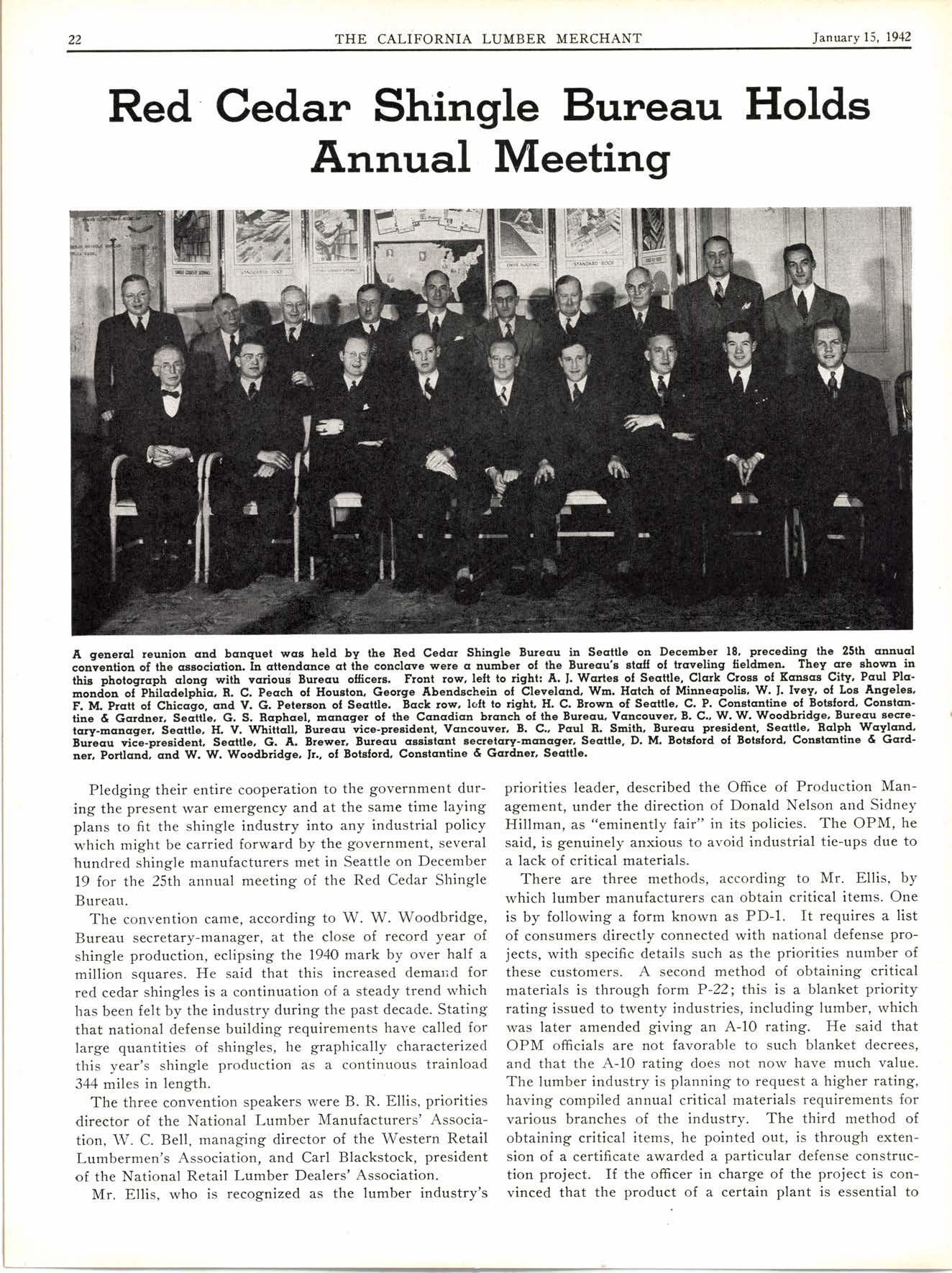
2 minute read
Red Cedar Shingle Bureau Holds Annual Meeting
i:::;;li qt4$lirytrij
A genercl reunion cnd bcnquet wcs held by the 8ed Cedar Shiagle Burecru in Setrttle on December 18, precedingr the 25th_ qnaucl con-vention of tbe cgaocicttion. ln cttendonce qi the conclave were tr number of lhe Buresu's stcll ol trcveling lieldmen" They cre shown-in ttig plotogtaph clong witb vqrioui Burequ officers. Front row, lelt to right: A. l. W_crtee_ol Seattle, Clcrk Croas 9l Kqnscs City, Pcul P-lc' -o"ali of pfitoa.tpfla, R. C. Peach ol Houeton, George Abendgchein oI Cleveltrnd, Wm. Hctch ol MinnecpoliB, W. I. Ivey- ol Loe Angeles, i. 14 pr"tt ol Chiccio, cnd V. G. Petergon of Secitle. BccL row, le'lt to right, H. C. Browa__of Seqttle, C. P. Conetcmtine oI BotElord, Conrtan' tine d Gcrdner, Sedttie, G. S. Rcphcrel, rncrncger oI the Cqncrdiqn brcrnch of the Burequ, Vcncouver, B. C., W. W' Woodbddg_e,8ure-g-u sece-i;ty-;";;d, 3ecnle, tt. V. Wtritictl, iurequ -vice-preaident, Vcncouver, B. C., Pcrut R. Snith, Buresu president, Seqttle, Rclpb Wcvltnd, Bwecru vije-president, Setrttle, G. A. Brewer, Burelu cgsistqnl secretqry-ncsnqger, Secttle, D. M. Botelord oI Botslord, Conrlcrntine d Gardner, Portlcrnd, cnd W. W. Woodbridge, Ir., ol Botglord, Congtcrntine 6 Gcrdner, Secttle.
Pledging their entire cooperation to the government during the present war emergency and at the same time laying plans to fit the shingle industry into any industrial policy which might be carried forward by the government, several hundred shingle manufacturers met in Seattle on December 19 for the 25th annual meeting of the Red Cedar Shingle Bureau.
The convention came, according to W. W. Woodbridge, Bureau secretary-manager, at the close of record year of shingle production, eclipsing the l94O mark by over half a million squares. He said that this increased demar;d for red cedar shingles is a continuation of a steady trend which has been felt by the industry during the past decade. Stating that national defense building requirements have called for large quantities of shingles, he graphically characterized this year's shingle production as a continuous trainload 344 miles in length.
The three convention speakers were B. R. Ellis, priorities director of the National Lumber Manufacturers' Association, W. C. Bell, managing director of the Western Retail Lumbermen's Association, and Carl Blackstock, president of the National Retail Lumber Dealers' Association.
Mr. Ellis, who is recognized as the lumber industry's priorities leader, described the Office of Production Management, under the direction of Donald Nelson and Sidney Hillman, as "eminently fair" in its policies. The OPM, he said, is genuinely anxious to avoid industrial tie-ups due to a lack of critical materials.
There are three methods, according to Mr. Ellis, by which lumber manufacturers can obtain critical items. One is by follorving a form known as PD-l. It requires a list of consumers directly connected with national defense projects, with specific details such as the priorities number of these customers. A second method of obtaining critical materials is through f.orm P-22; this is a blanket priority rating issued to twenty industries, including lumber, which was later amended giving an A-10 rating. He said that OPM officials are not favorable to such blanket decrees, and that the A-10 rating does not now have much value. The lumber industry is planning to request a higher rating, having compiled annual critical materials requirements for various branches of the industry. The third method of obtaining critical items, he pointed out, is through extension of a certificate awarded a particular defense constrttction project. If the officer in charge of the project is convinced that the product of a certain plant is essential to









